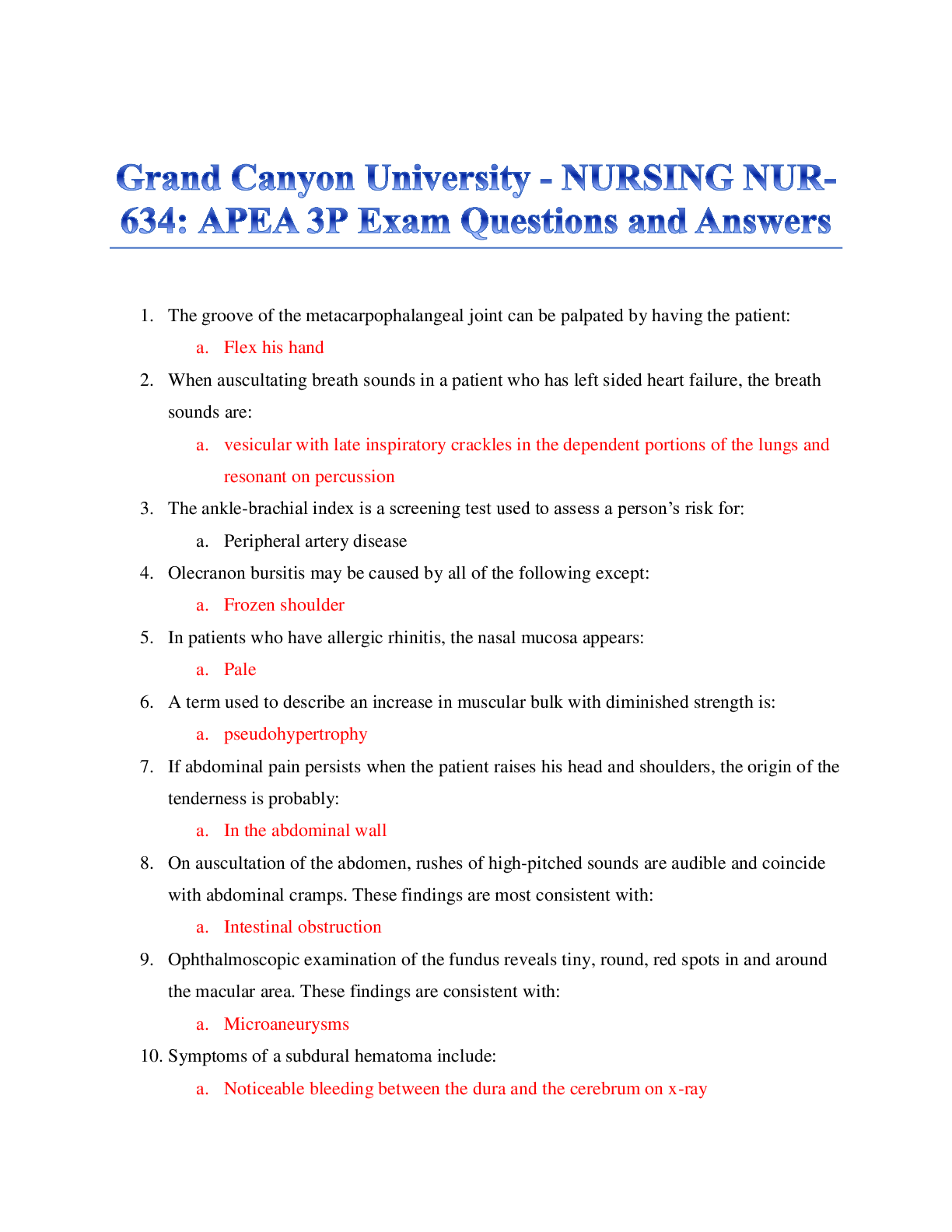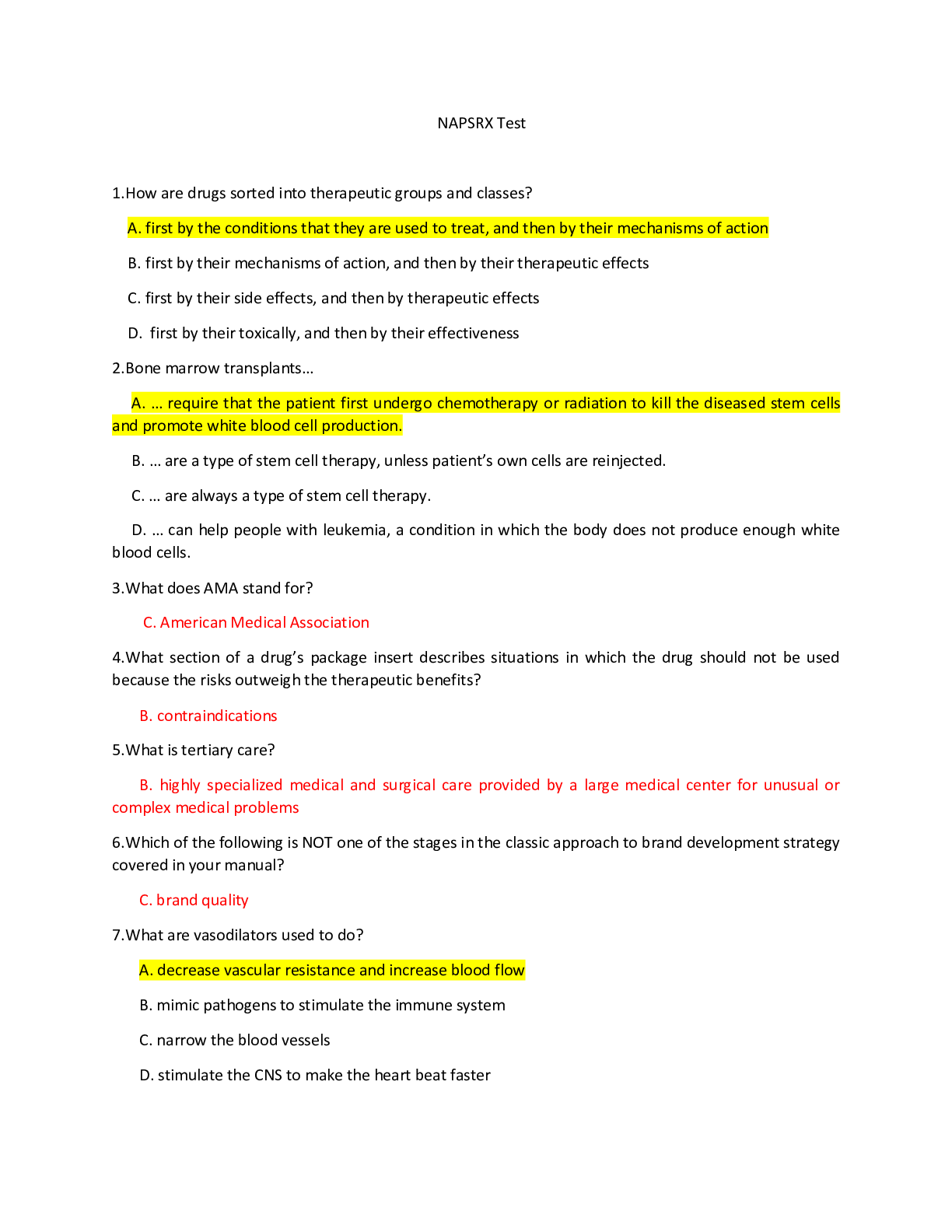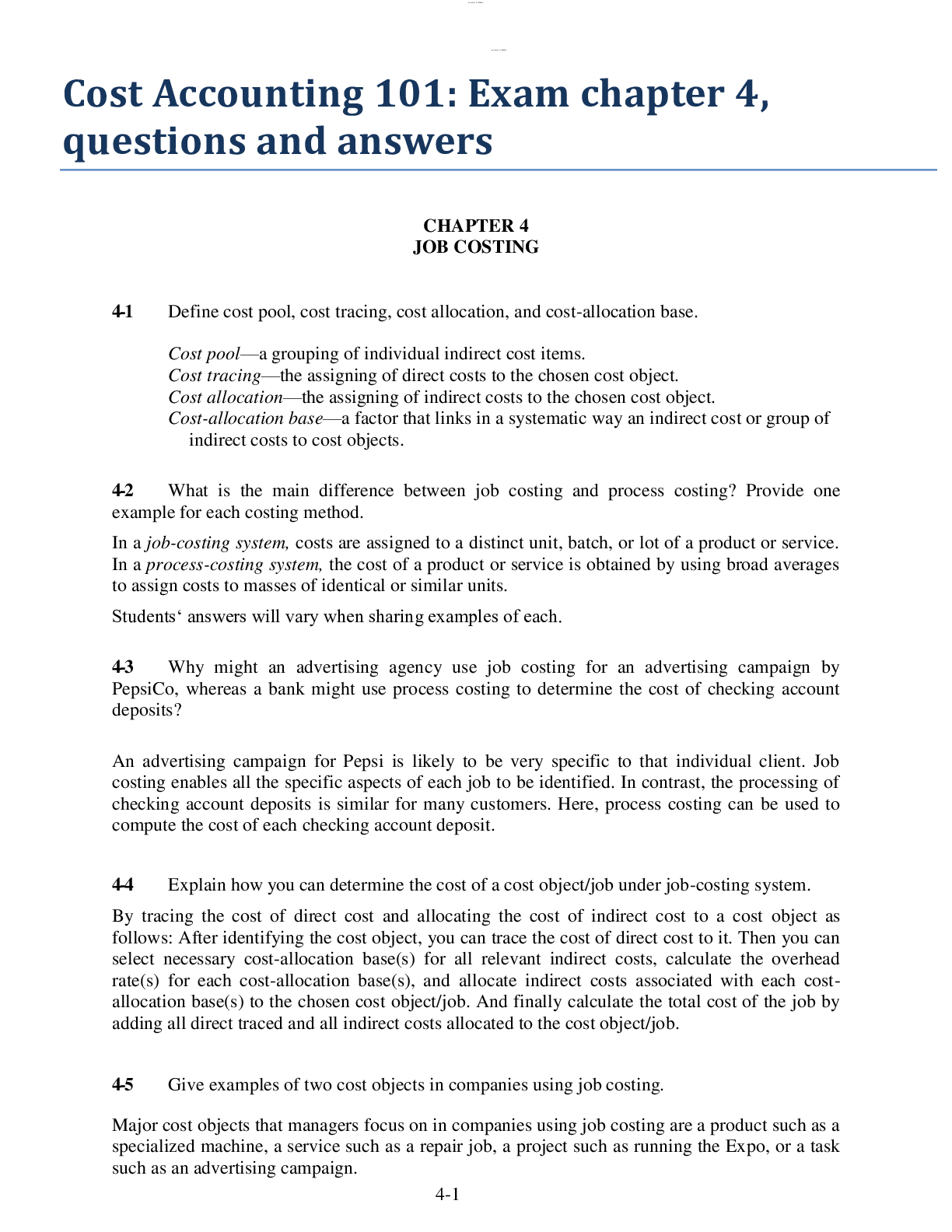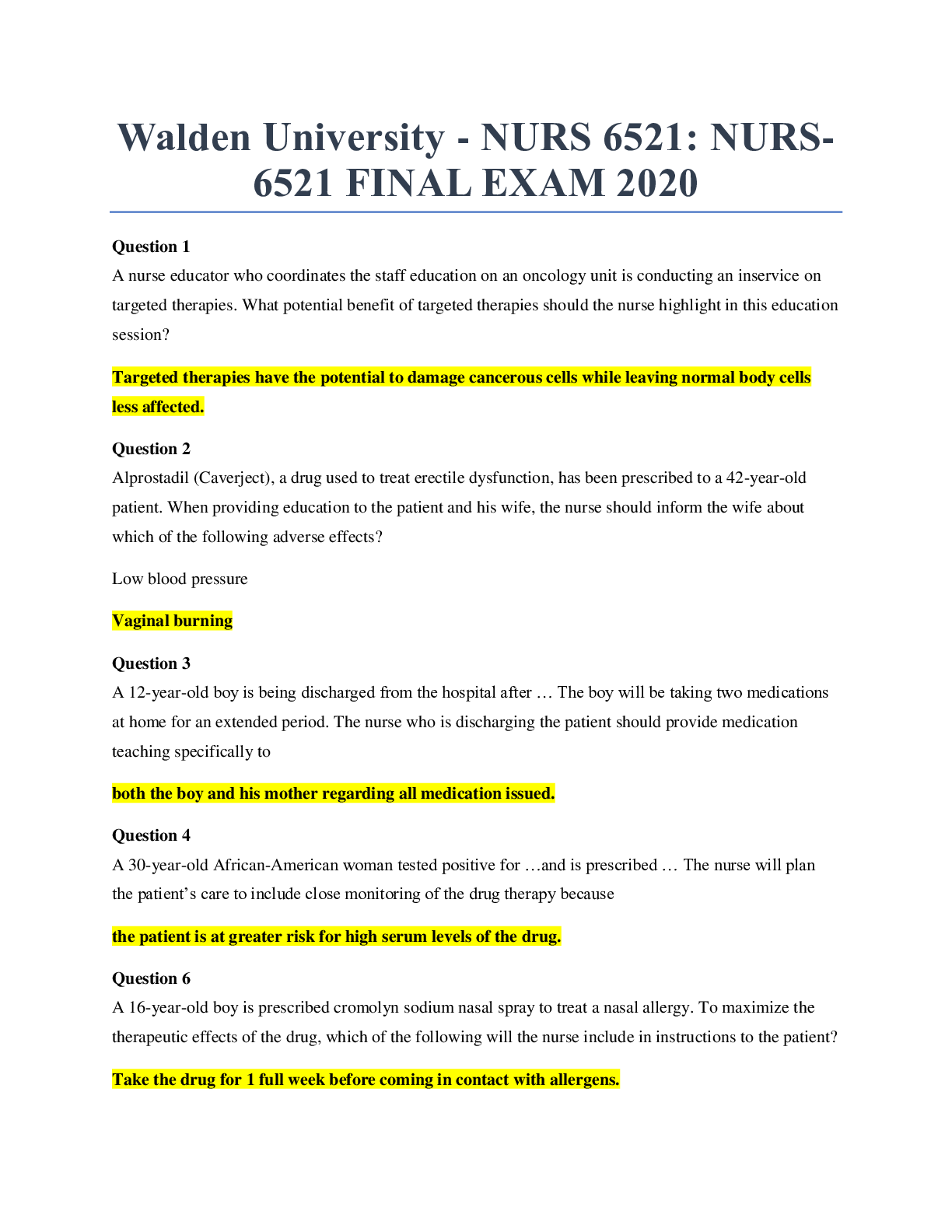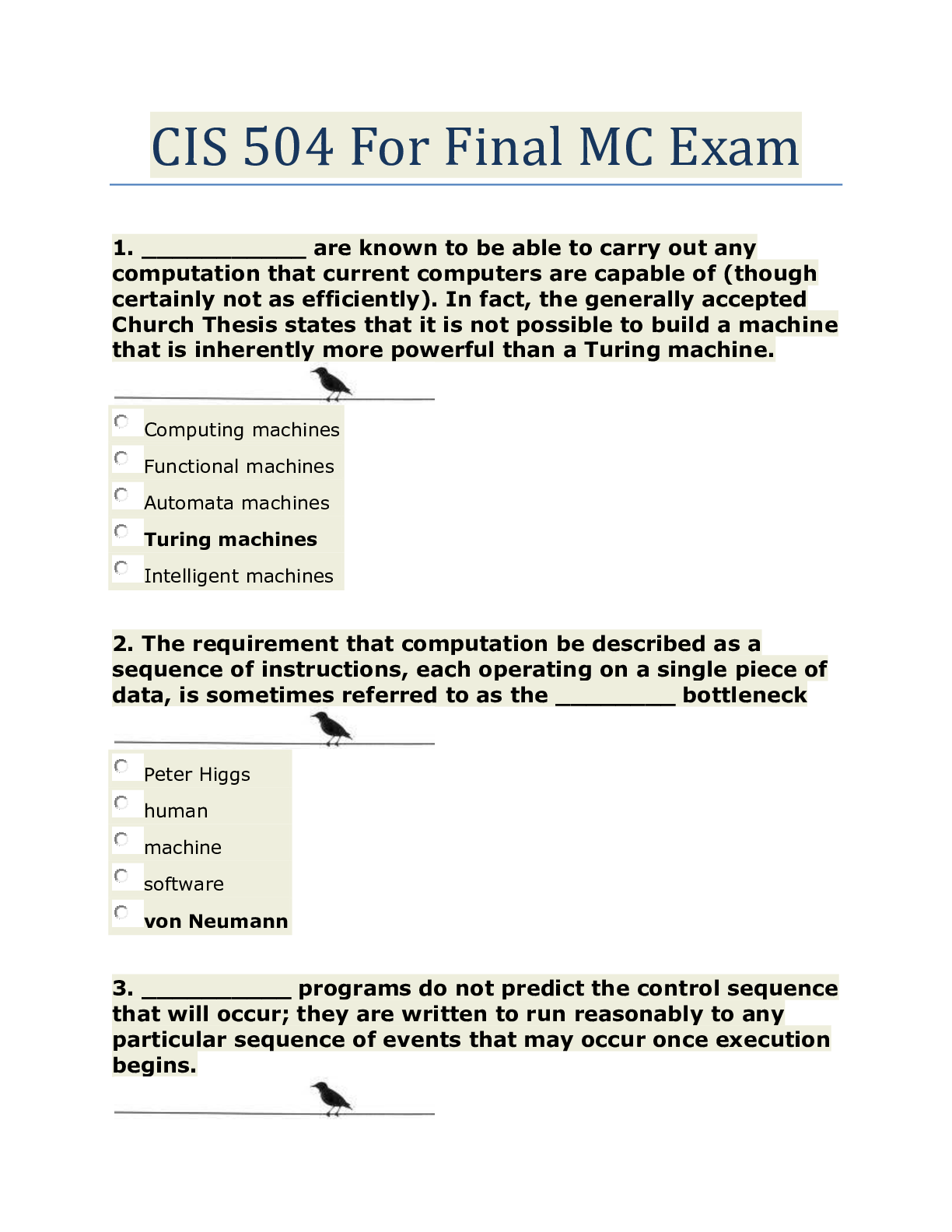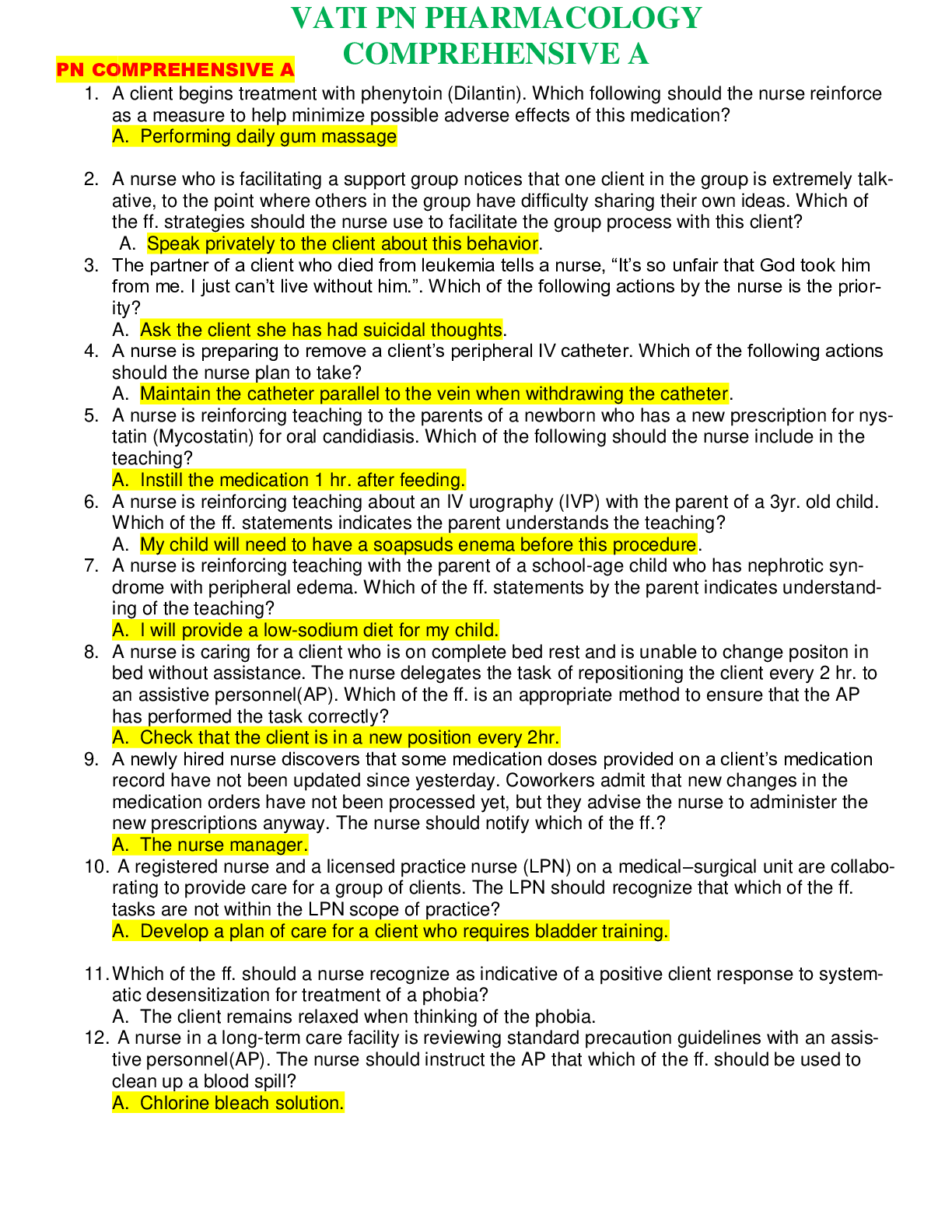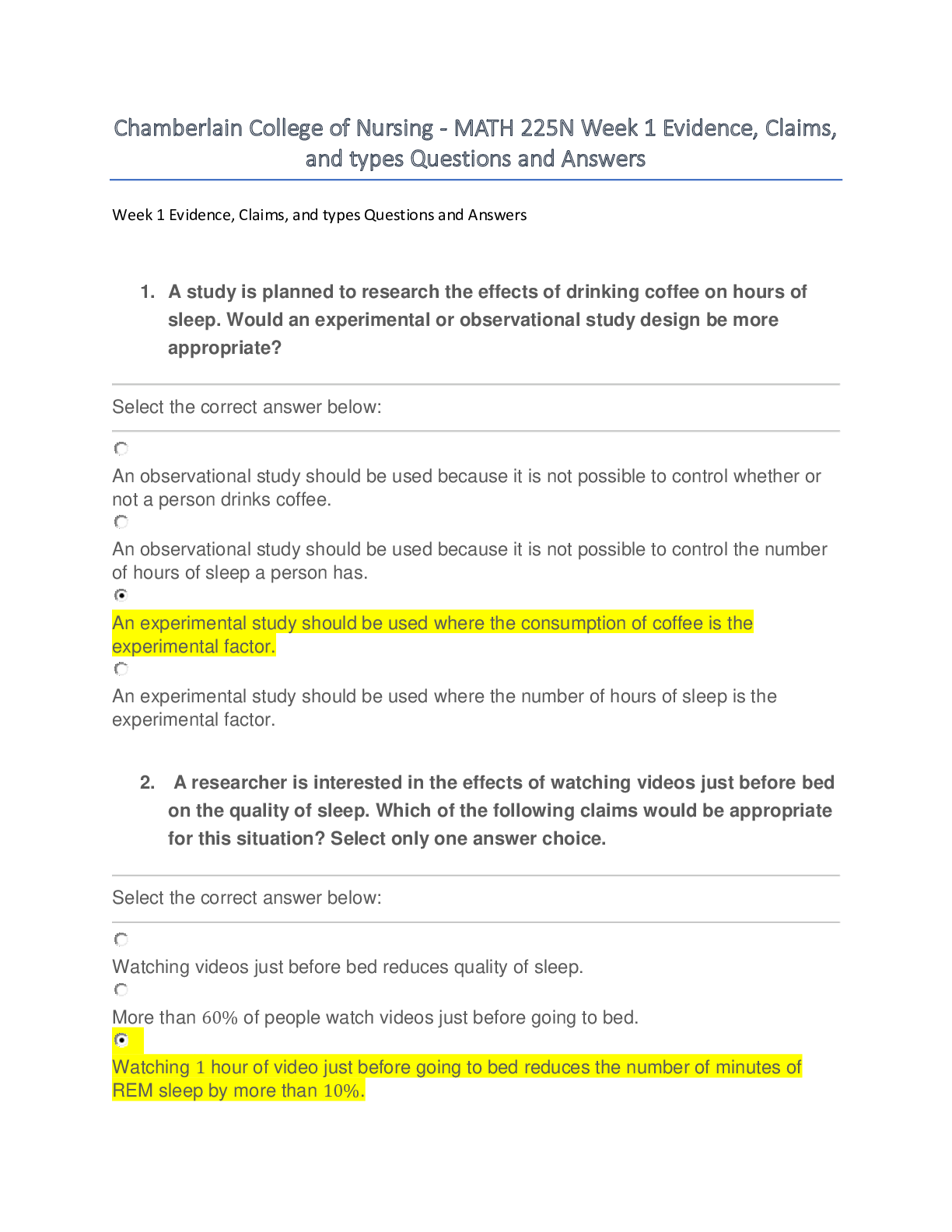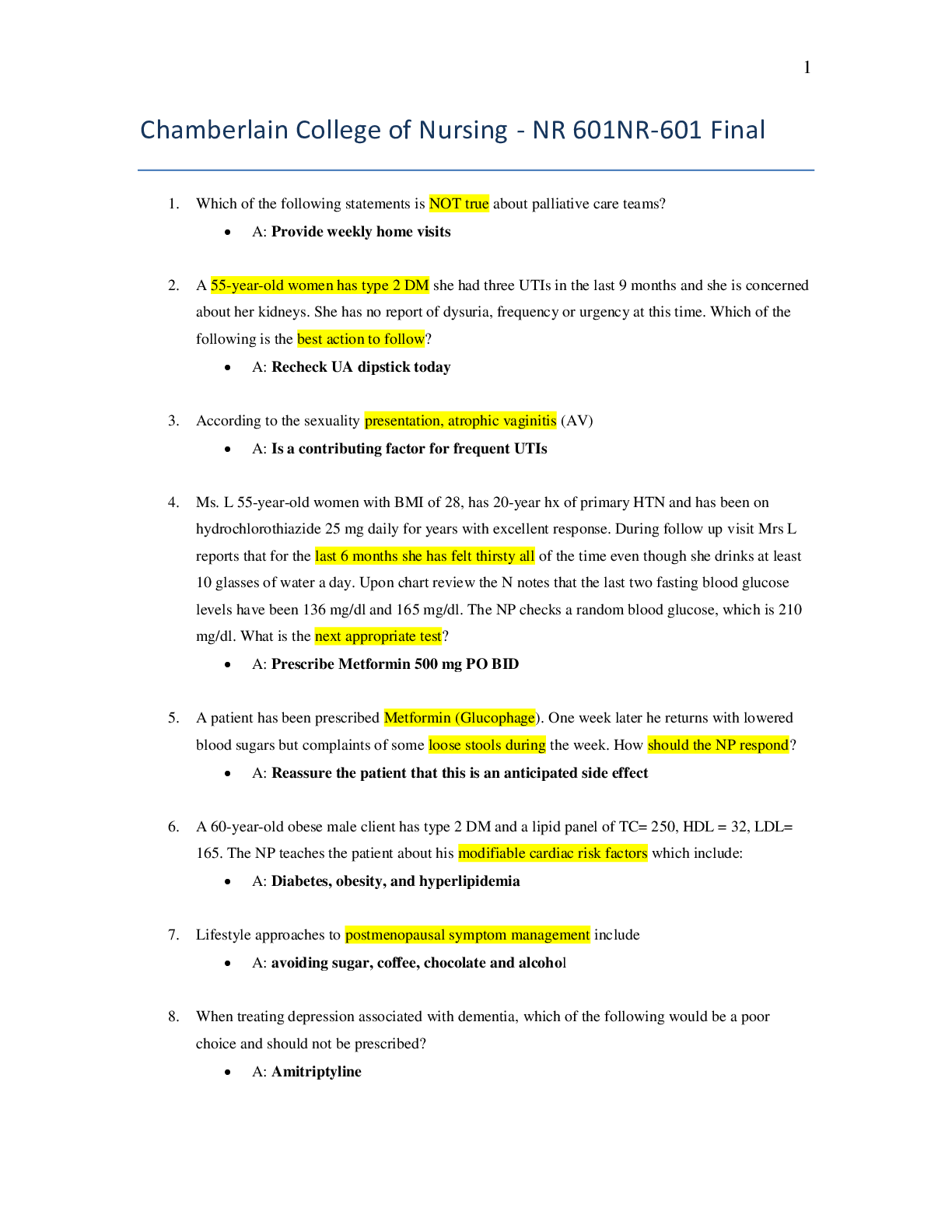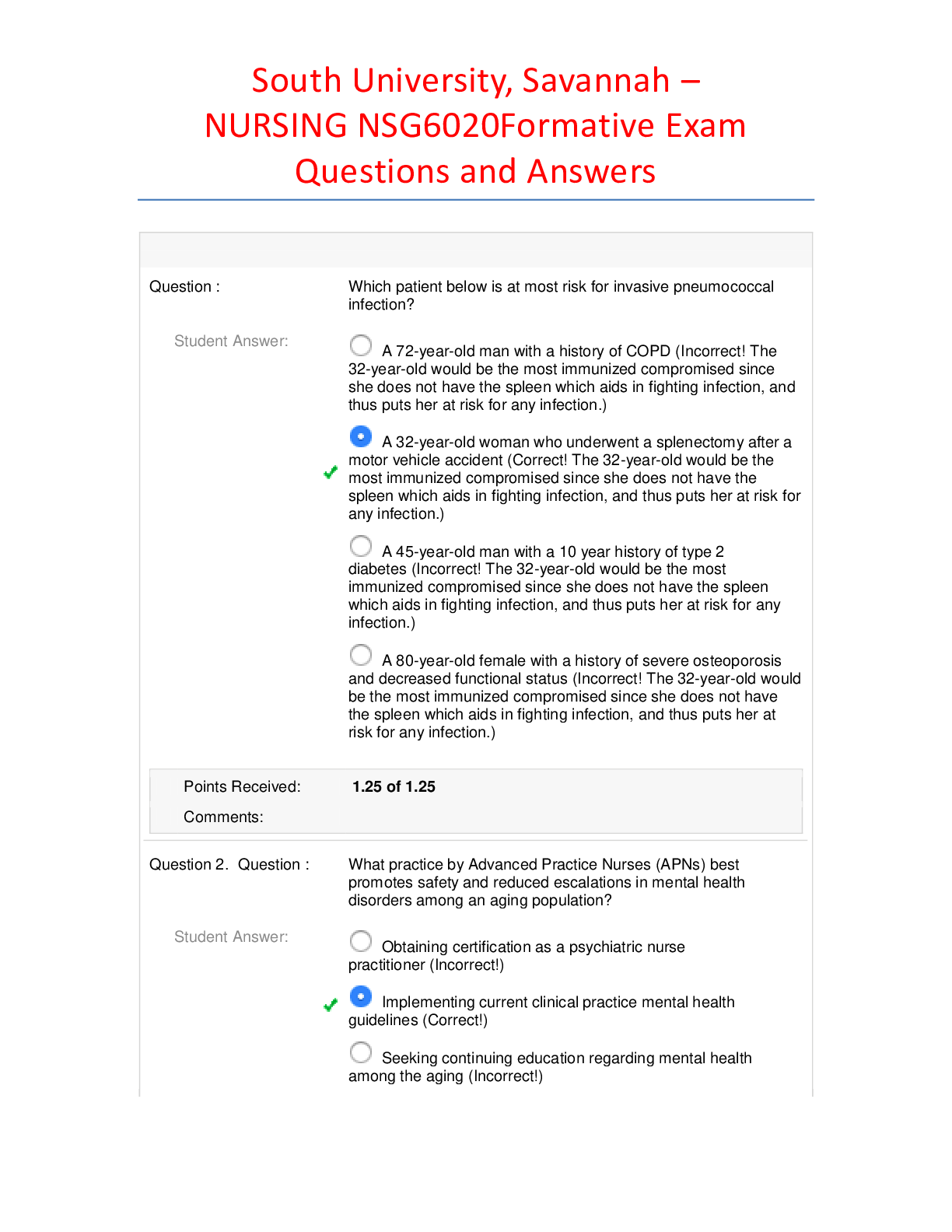BioChemistry > EXAM > University of Minnesota - MICB 3301 EXAM 4. 100 %. Includes notes and the Most Commonly Tested Quest (All)
University of Minnesota - MICB 3301 EXAM 4. 100 %. Includes notes and the Most Commonly Tested Questions and Answers.
Document Content and Description Below
University of Minnesota - MICB 3301 EXAM 4 Major Histocompatib-ility complex What is the human version of MHC? Human Leukocyte Granzymes released, target cell pathogen -induce apoptosis ... Perforins proteins that poke holes in pathogens and allow toxins to enter What do T-cells release upon binding to MHC Class II release cytokines, TNF to activate B cells Pathogen Carrier infected individual, potential source of infection; carrying but not expressing symptoms Zoonoses disease transmitted to humans from animals Vectors organisms that transmit disease to humans; Ex. mosquitos (plasmodium), ticks (Burella burgdofori, lymes disease), flea (Yersinia pestis, bubonic plague) Latency pathogen stops reproducing, dormant can be come active again; Ex. Herpes, Chicken pox Pathogenicity ability to produce disease Virulence degree of pathogenicity Virulence Factors or determinants genetic, biochemical, structural features; contribute to virulence Pathogenicity Islands -large segments of chromosomal or plasmid DNA encoding virulence determinants - How do we measure virulence? 2 ways -Infectious dose 50 - Viral Multiplication- The Viral Life Cycle (5 steps) 1. Attachment to host cell 2. Entry and Uncoating Two spike proteins in release and attachment hemagglutinin spike and Viruses can spread via...? viruses can spread by using blood, neuronal and lymphatic systems synctia -multinucleated giant cells; cause fusion of the cells (HIV does this) -Uses this for cell replication Tropism -directed infection for a specific organ or tissue -determined by cell host receptor Ways Viruses can evade Both Innate and Adaptive Immune responses ( 2 ways each) Innate: Adaptive: Block antigen processing, MHC export -Evade antibody via Antigenic Variation Antigenic Variation -a change in AA sequence in its virion spike for example (so many changes that a vaccine can't be made for cells) -Changes occur from RNA Replicase -Also 2 Types: *Antigenic Drift (minor) *Antigenic Shift (major) 4 "General" Mechanisms of Bacterial to be pathogenic (I-ACE) - *Pathogenicity is most often Multifactorial Coagulase -coagulates by fibrinogen in plasma; -by covering itself with fibrinogen; -protecting it from host detection Streptokinase only works once in Stroke/heartattack individuals because B-cells remember Hemolysins -enzyme digesting RBC - IgA protease -breakdown IgA immoglobin (in secretion, mucus) -before it could infect microbe -breaks antibodies into Fab and FC parts Leukocidans -go after leukocites -causes degranulation of lysozymes giving more motility -Degrades extracellular DNA Two Bacterial Adherence Factors Example of Pili adherence factors Type I pili of uropathogenic E. coli bind mannose residues on human cells Examples of Microbes using Capsule as adherence factors -Sreptococcus pneumonia - -Glistening appearance Invasion and Spread ex. wounds, insect bites -once below mucous membrane, bacterium can spread to deeper tissues (colonize and spread in vivo Colonization in blood stream -bacterema- bacteria present in bloodstream bacterema bacteria present in bloodstream Bacterial Pathogens can Evade Adaptive Immune Responses -Capsules -IgA proteases -Antigenic Variation (changing cell surface outer membrane or pili protein via AA changes) Bacterial Pathogens can Evade Innate Immune Responses -Evading Complement *capsules-inhibit opsonization, membrane attack complex *Proteases *Lengthened O-Side chains on LPS (Lipid Poly Saccharide) -block TLR signaling, cytokine expression (this is blocked) Evading Phagocytosis -Capsules -Block phagocytic cells (impedes process of phagocytosis) *Streptococcus pyogenes - M protein -Leukocidins - destroy phagocytes, also prevent fusion into phagolysosome by releasing compounds -proteases inactive complement for opsonization -Some microbes prevent APC (to make MHC) What is and what does Listeria monocytogenes cause? -intracellular bacterial pathogen -Psychrophile (replicate under refridgeration) - it polymerizes the actin at the end of the cell at one pole of the cell -Listeria can be engulfed by another phagocyte in its temporary protrusion What are 3 types of Bacterial Intracellular Pathogens? -Listeria monocytogenes -Mycobacterium tuberculosis -Legionella (legionaires disease in amoeba List 4 microbes and 3 tropisms of Bacteria using Biofilms to evade innate and adaptive immunity inner ear - Otitis Media *biofilms persistent due to resistant to antibiotics by forming protective matrix Frustrated phagocyte not being able to penetrate biofilms so try to release enzymes -excess release kills host cells Two types of toxins -Exotoxins - released by bacterial cells Membrane-Disrupting Exotoxins Pore-forming e -(embeds into host cell membrane) *Leukocidins *Hemolysis -both causes cell to swell by having contents spill out and water to flow in leading to cell lysis Superantigens of perforins and granzymes -Causes T cells to overexpress and release cytokines causing inflammation -leaky blood vessels -multiple organ failure cell receptor Ex. Corynebacterium Diptheriae, Vibrio Cholerae, Clostridium botulinum, Bordetella pertussis, O157:H7 (EHEC) E.coli, and Bacillus anthracis Diptheria toxin - Microbe and mechanism Ex. Corynebacterium diptheriae -Enters by receptor mediated endocytosis (B) - -2 to make proteins Vibrio Cholerae toxin mechanism -AB Exotoxin - Enterotoxin! - "the intestine" cells -aquatic microbe -ADP Ribosyltransferase (attaches ADP ribose) -Modifies a host G-protein -controls adnylate cylase causing increase in cAMP -Alters Na+ and Cl- transport causing H20 loss Chlostridium Botulinum toxin mechanism -Botulinum toxin (prevent muscle contraction) toxoid inactivated toxin but still can elicit immune response (vaccine) Antitoxin can neutralize toxicity Exotoxins and antigicity but remains antigenic DTaP Vaccine Deiptheria, Tetanus (lock jaw), and Pertussis (whooping cough) illicit immune response for protection Lipid A of LPS -Endotoxin -effects often indirect via TLR 4 (recognizes this as a PAMP) -stimulate TNR release - Petechia -blotchy blood vessels on skin -blood leaks out into tissue -Causes gangrenous (death of tissue) -Found in Neisseria menigitidis Type III Secretion systems *invasion, control host immune response, intracellular survival Injectisome -Genes on pathogenicity islands that are found on operons -has three structures: *pore - formed by bacterial proteins * plant cells Targets for Type III effectors intracellularly -host cell cytoskeleton *rearrangement of actin (prevents phagocytosis or promotes invasion) -host cell signaling *NKFB gets blocked to not signal cytokines to signal immune system What is EPEC and its Mechanism? -Enteropathogenic E. coli -major cause of infantile diarrhea - " after extending of actin after attachment Cidal kills the microbes Static inhibits growth of microbe, but NOT kill it Sterilization completely remove or kill all microbes (virus, fungi, bacteria, even spores) -ex. Autoclave Disinfection reduction of microbial population, destruction of pathogens -not complete but reduce Sanitization reduction of microbial contamination "to levels safe by public health standards" Antiseptic Two types of Pasteurization -(62.8 degrees) - 30 mins, then rapid cool -(72 degrees) - 15 sec, then rapid cool -Kills Listeria, Salmonella *Doesn't sterilize but kills most pathogens Antimicrobial agents fxn -used *microbial products that kill or inhibit *different from synthetically made in labs Ex. Bacitracin & Polymyxins (Bacillus); Penicillin (Penicillium); Cephalosporins (Cephalosporium) Paul Ehrlich -Selective toxicity -develop an agent and inhibit a germ and not kill the person (static) Alexander Flemming accidently rediscovered penicillin Florey, Chain, and Heatly purified penicillin, when injected into mice infected with Staphylococcus, mice survived Selman Waksman and identified streptomycin Broad spectrum vs. Narrow Spectrum -Broad spectrum - attack many different pathogens (ex. penicillin) -narrow spectrum - attack only a few different pathogens Considerations in making antibiotics -allergies -toxic -broad/narrow advantage -effective concentration -doesn't eliminate microflora Clostridium difficile -Pseudomembranous -Bacillus Antimicrobial agent Targets: 5 targets -cell wall -plasma membrane -Nucleic acid synthesis -Protein synthesis -Metabolic enzymes Penicillins Structure, target and fxn -gram + peptidoglycan cell wall target -broad or narrow, cidal -structureal feature: *beta-lactam ring + R group stability (stability in stomach for ex.) and spectrum (increase # of microbes targeted) -Inhibit bacterial Penicillin Binding Proteins (PBPs) for transpeptidiation 3 cell wall inhibitors -Penicillin -Cephalosporin -Vancomycin -Bacitracin Penicillin Binding Proteins and Transpeptidiation -inhibited by to not form crosslinking -cells will lyse without crosslinking Cephalosporins -beta-lactam structure -often given to patients w/ penicillin allergies Vancomycin - cross-linking site) to bolck transpeptidiation Bacitracin -Cell 3 Plasma Membrane Inhibitors types -Polymyxins -Miconazole -Nystatin Polymyxins -Ex. Colistin - Miconazole -plasma mem inhibitor -antifungal agents - -Candida yeast infections and athlete foots Nystatin -plasma mem inhibitor -antifungal agent -binds sterols -candida yeast infection 2 Nucleic Acid inhibitors types -Quinolones -Rifampin Quinolones -Nucleic Acid Inhibitors Ex. Nalidixic Acid, Ciproflaxcin -Cidal, Broad Spectrum -synthetic RNA polymerase 3 Protein Synthesis Inhibitors types -Aminoglycosides (cidal) -Tetracyclines (static) -Macrolides (static) Aminoglycosides -EX. Streptomycin, Kanamycin -protein synthesis inhibitor -cidal -binds 30S causing mRNA misreading Tetracyclines -Protein synthesis inhibitor Macrolides -Ex. Erythromycin, Azithromycin (treats chalmidia), Chloramphenicol -Protein synthesis inhibitor -Binds 23 rRNA of 50S -blocks peptide elongation Azithromycin -Static, Protein Synthesis Inhibitor -binds to 23 rRNA of 50S -treats chlamidia 3 Metabolic Enzyme Inhibitors types -Sulfonamides & Trimethoprim -Triclosan Sulfonamides & Trimethoprim -Static, Synthetic agent -metabolic enzyme inhibitors -distrupts metabolic pathways - Triclosan -Broad spectrum, antibacterial -Metabolic Enzyme inhibitors -binds enoyl reductase- enzyme for fatty acid synthesis Antiviral Drugs -Acyclovir -Tamiflu -HAART (HIV) -Azidothymidine (HIV) -Ritonavir (HIV) Acyclovir -Anti-viral Drug -inhibits DNA pol. of herpes virus using Guanine Analog Tamiflu -Anti-viral drug -blocks catalytic active site of neuraminidase *(spike protein that release for virion that cleaves glycolipids) HAART Highly Active Antiviral Retrovirus Therapy -Anti-HIV drug Azidothymidine (AZT) -Anti-HIV durgs -targets reverse transcriptase and blocks -nucleoside analog, cuases DNA chain termination -uses an azido group instead of alcohol on sugar Ritonavir -Anti-HIV Drug -Inhbits HIV Protease *processes viral proteins for virion assembly 3 Antiprotozoan Drugs types -Chloroquine (malaria) -Malarone (malaria) -Metronidazole (Giardia) Chloroquine -Anti-protozoan drug -targets Malaria Malarone -Antiprotozoan drug -targets malaria Metronidazole -antiprotozoan drug Name 2 Superbugs -Vancomycin Resistant Enterococcus (VRE) Nosocomial hospital-acquired infection Vancomycin Resistant Enterococcus (VRE) -Superbug Methicillin Resistant Staphylococcus aureus (MRSA) -Superbug -Nosocomial Mechanisms of Drug Resistance -R-plasmids *Transfer via conjugation from one cell to another Ways to prevent Drug Resistance in Microbes -Antibiotics create environments that select for antibiotic-resistant mutants Clavulamic Acid -Targets Penicillinase Different Groups of Sources and Transmission of Viral Diseases -Airborne (3) -Food and Water-Borne (2) 3 Airbone Viral Diseases 2 Food and Water-Borne Viral Diseases -Gastroenteritis -Polio 3 Athropod-Borne Viral Diseases - *caused by Flava Viruses 2 Zoonotic Viral Diseases -Ebola Hemorrhagic fever 5 Direct Contact Viral Diseases -Common Cold -Mono Chickenpox -Disease (C.Pox is not the virus) -Varicella-Zoster Virus *family Shingles -individuals who recover from chickenpox are often resistant to disease - infect only ONE Side 2 types of Vaccines -Inactivated (killed) -Attenuated (live but avirulent) Inactivated Vaccines -Killed vaccine Attenuated Vaccine -Live, but avirulent Herd Immunity Resistance of a population to infect and spread of an infectious agent due to immunity of a high percentage of the population Influenza (flu) -Airborne Viral Disease List Influenza cycle not following these numbers 1. Receptor Mediated Endocytosis (Hemagglutinin Spikes to Sialic Acid 2. Embeds in Endosome 3. Entry into Nucleus (normally virus replicates in cytoplasm) Antigenic drift -minor -single AA changes -mutations in viral genes in single strain - Due to viral RNA replicase- prone to error Antigenic Shift -Major -Different strains (animal or human) infect cell; genomes reassort Epidemics versus Pandemics MMR -Measles, Mumps, Rubella -Airborne Viral Disease Arboviruses -spread vector in arthropod -All caused by Flaviviruses Yellow Fever -Arthropod-Borne Viral Disease -Caused by Flavivirus -vaccine West Nile Fever -Arthropod-Borne Viral Disease -Caused by Flavivirus -No vaccine Dengue Fever -Arthropod-Borne Viral Disease Flavivirus - (+)ssRNA, envoloped, icosahedral Common Cold - Mononucleosis (mono) -Direct Contact viral disease -Epstein_Varr Virus (Herpesviridiae) -Form Downey cells: AIDS/HIV -Acquired Immune Deficiency Syndrome -Direct Contact Viral Disease HIV, Disease, Structure, Gene name -Human Immunodeficiency Virus ) HIV Life Cycle 1. Binds - Then fusion between host and virus HIV Transmission and Pathogenesis -infected blood, semen or vaginal secretions come in contact with uninfected broken skin or mucous Gastroenteritis -Food and Water-Borne Viral disease -Norovirus Polio -Food and Water-Borne Viral disease Ebola Hemorrhagic fever -Zoonotic Viral disease -Ebola Rabies -Zoonotic Viral disease *RNA, Bullet shaped, enveloped - 4 types of Bacterial Diseases transmission -Airborne (4) 4 Types of Airborne Bacterial Diseases -Tuberculosis 2 Types of Direct Contact Bacterial Diseases 2 Types of Arthropod-Borne Bacterial Diseases 3 Types of Food, Water-Borne Bacterial Diseases -Cholera Tuberculosis (pathogenicity) -Airborne Bacterial Disease -Mycobacterium tuberculosis - organs leading to death Mycobacterium Tuberculosis - mode of action - TB Skin Test and Vaccine -The Mantoux Tuberculin Skin Test TB Detection and Therapy -Diagnosis *Bloody sputum, chest x-ray, acid-fast staining, culture (slow growth) emerging MDR and XDR -Multi Drug Resistant -Extreme Drug Resistant Streptococcal Diseases, microbes, description, and treatment -Airborne Bacterial Disease -Streptococcus pyogenes (beta-hemolytic) or Streptococcus pneumoniae (ear infection) Streptococcal Virulence Determinants -Capsule - Group A Streptococci invasive infections Ex. Necrotizing fasciitis and allows healthy tissue to grow Streptococcus mutans air Pertussis (Whooping Cough) -Airborne Bacterial Disease (Gram (-) ) ribosyltransferase that increases cGMP to cause massive mucous secretion DTP/DTaP Vaccine and other treatment -Diptheria (acellular) Pertussis Meningitis -Airborne Bacterial Disease -Inflammation brain, spinal cord meningies (membranes) Neisseria meningitidis -Airborne Bacterial Disease Plague (2 types) -Arthropod-Borne Bacterial diseases -from Fleas Bubonic Plague -Arthropod Bacterial Disease Pneumonic Plague Lyme Disease description of microbe and vector -Arthopod-Borne Bacterial Disease -Tick-Borne (Lyme named after town) Symptoms and Treating Stages of Lyme Disease -localized (7-10 days) *bulls eye rash, flue like symptoms *most treatable stage system Anthrax -Direct Contact Bacterial Disease -Bacillus anthracis 2 forms of Anthrax and Treatment -cutaneous: from out/abrassion Staphylococal Diseases -Direct Contact Bacterial Disease aureus), food poisoning Staphylococcus aureus Virulence Factors -Direct Contact Bacterial Disease -Superantigen (TSST-1) Toxic shock Biofilms -resistant to antibiotics -impedes immune response (frustrated macrophage) Airborne Bacterial diseases (Genus, Species) 6 total -Mycobacterium tuberculosis -Streptococcus pyogenes (Group A, Beta-hemolytic) orStreptococcus pneumoniae Arthropod-Borne Bacterial Disease (Genus, Species) 2 types -Yersinia pestis (fleas) Food, Water-Borne Bacterial diseases (Genus, Species) 5 types AND treatment -Vibrio cholerae -Clostridium botulinum Cholera -Food, water-borne Bacterial Disease -Vibrio Cholerae Listeriosis -Food Borne Bacterial Disease -Listeria monocytogenes Botulism -Food Borne Bacterial Disease Escherichia coli O157:H7 -enterohemorrhagic E. coli (EHEC) -carriers - cattle, swine (no symptoms) *shed strains in 6 Microbes that have AB Toxins -Corynebacterium diptheriae -Clostridum botulinum What is EHEC Enterohemorrhagic E.coli What is HUS? Hemolytic Uremic Syndrome General Steps for glycolysis fermentation (reactant, intermediates (4), and products (3)) -Reactant: Glucose Yogurt Producing Bacteria -Lactic Acid Bacteria -Lactobacillus Cheese Production (2 Bacteria, 1 Fungus) 1 additive -Lactococcus lactis (starter culture) Bifidobacterium -example of probiotic tablet Probiotic microbes added to diet to Clostridium difficile -causes pseudomembranous colitis Dr. Alexander Khoruts His work with probiotics in tran How is beer made? -Malting and Mashing -Add plant enzymes to break down complex starches and protein What are Hops? flavoring agents and antibacterial compound added in beer brewing What is a "must"? -liquid from grapes What are Biofuels Fuel from biological sources Metabolic products made by microbes fall into 2 categories -Primary metabolites (req. for growth) Primary metabolites Secondary metabolites industrial microbiology Microbial ecology Genomics Infectious disease 4 Microbes that have Type III Secretion Systems [Show More]
Last updated: 2 years ago
Preview 1 out of 26 pages

Buy this document to get the full access instantly
Instant Download Access after purchase
Buy NowInstant download
We Accept:

Reviews( 0 )
$9.50
Can't find what you want? Try our AI powered Search
Document information
Connected school, study & course
About the document
Uploaded On
Dec 02, 2020
Number of pages
26
Written in
Additional information
This document has been written for:
Uploaded
Dec 02, 2020
Downloads
0
Views
120

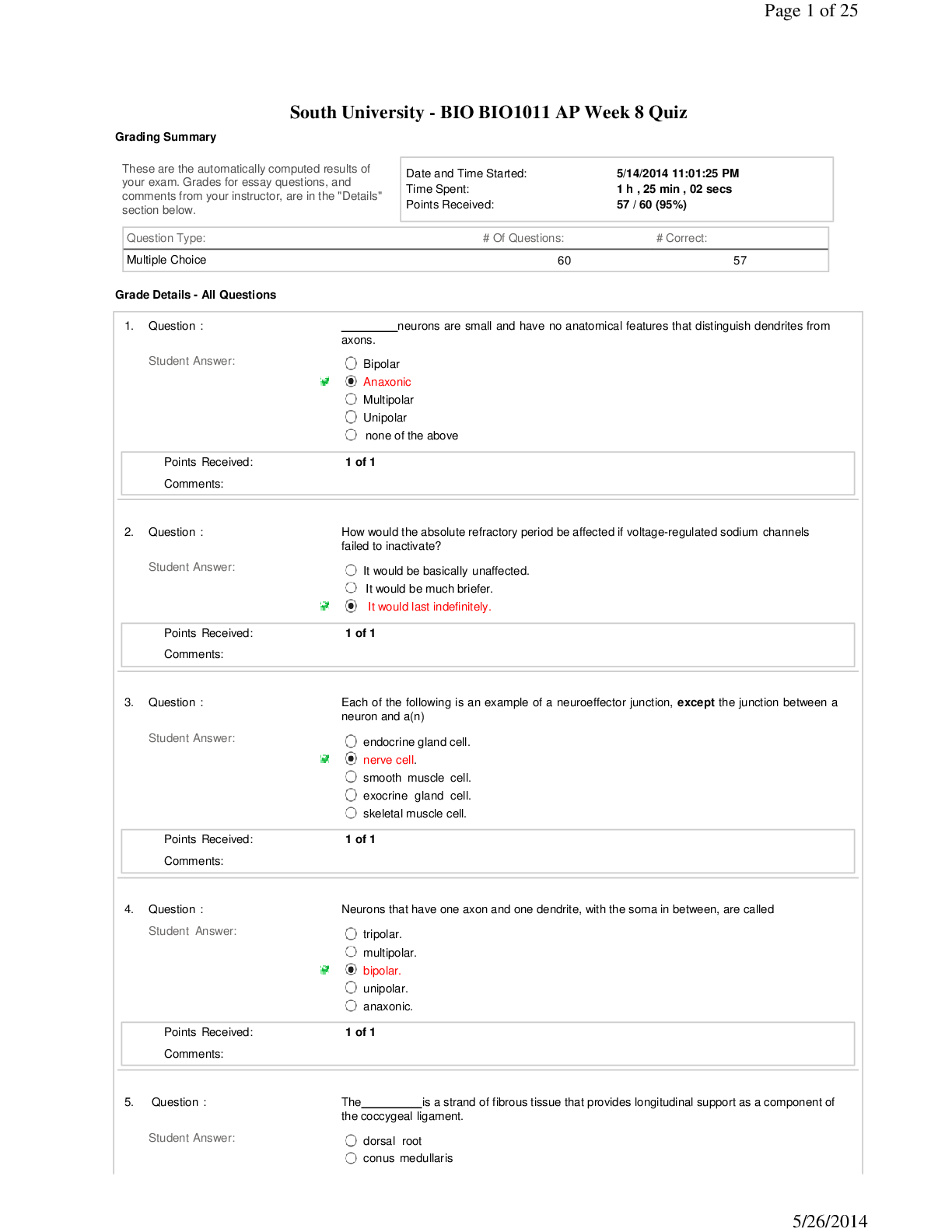
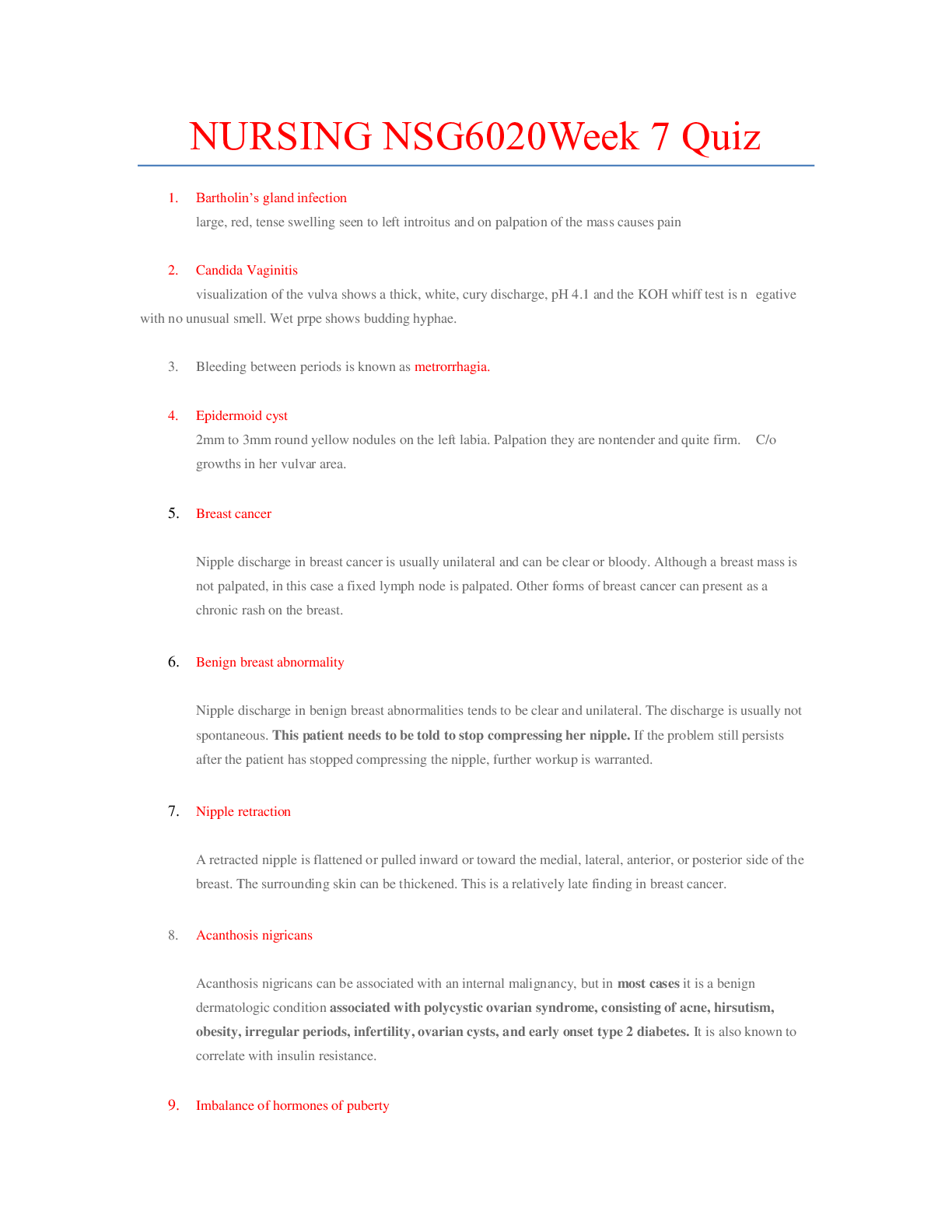
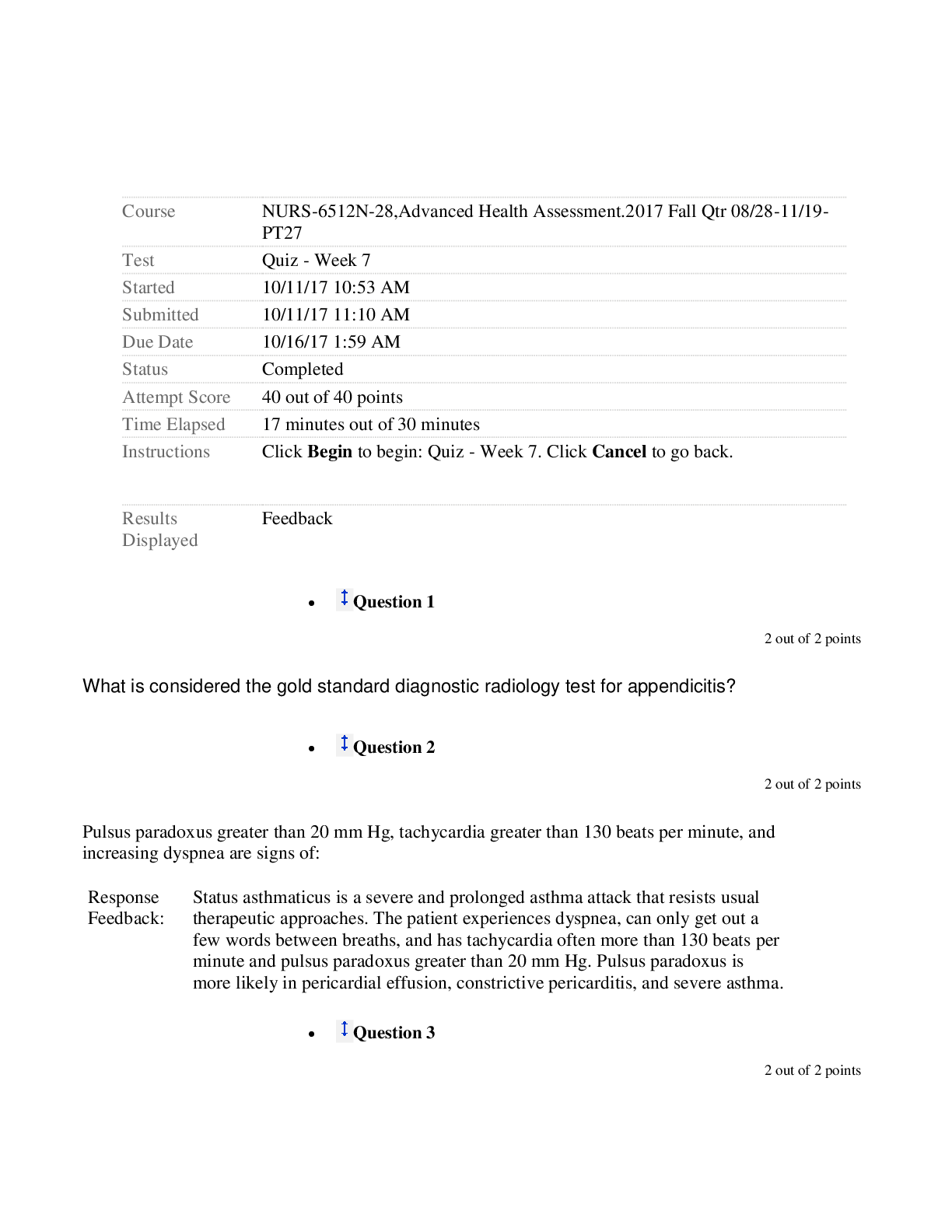



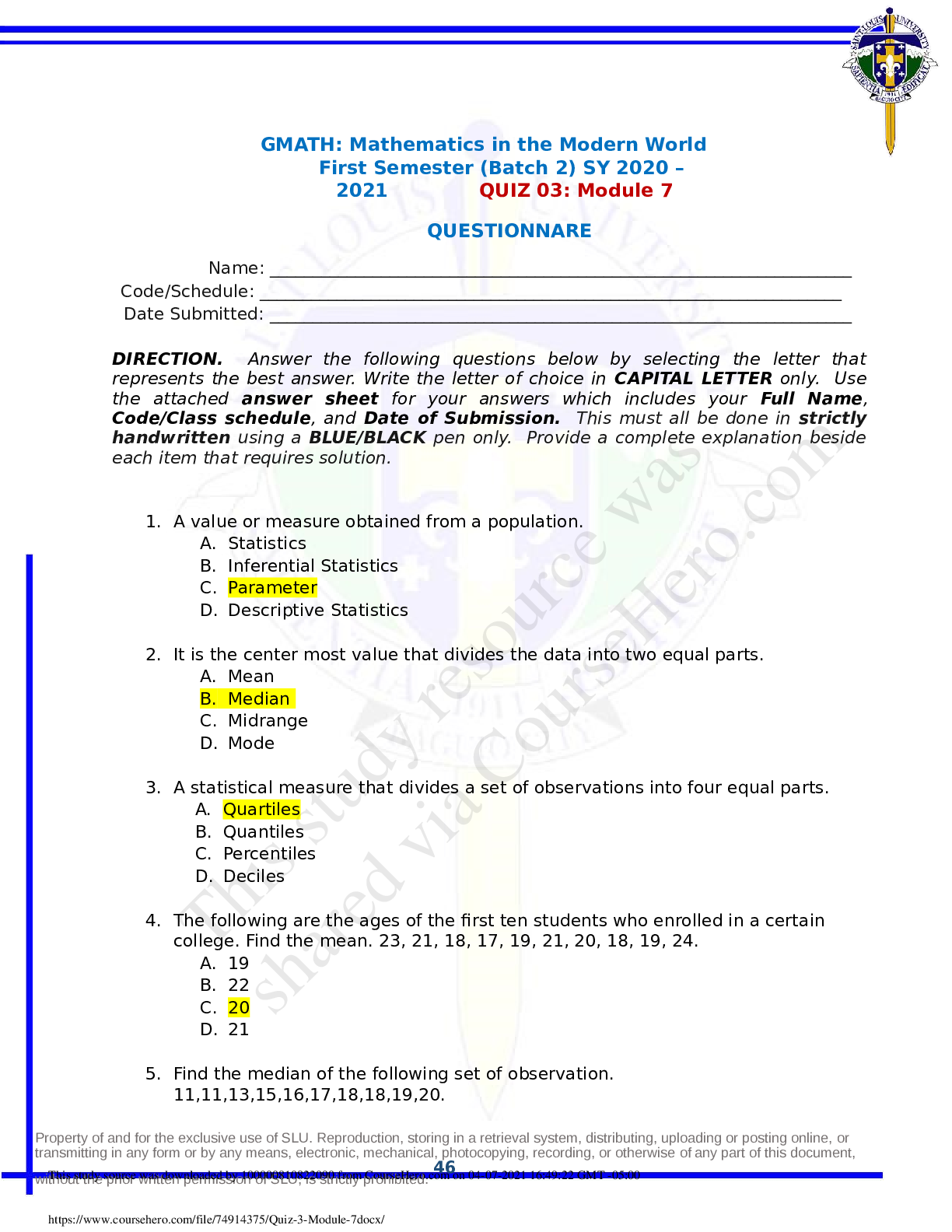



.png)



